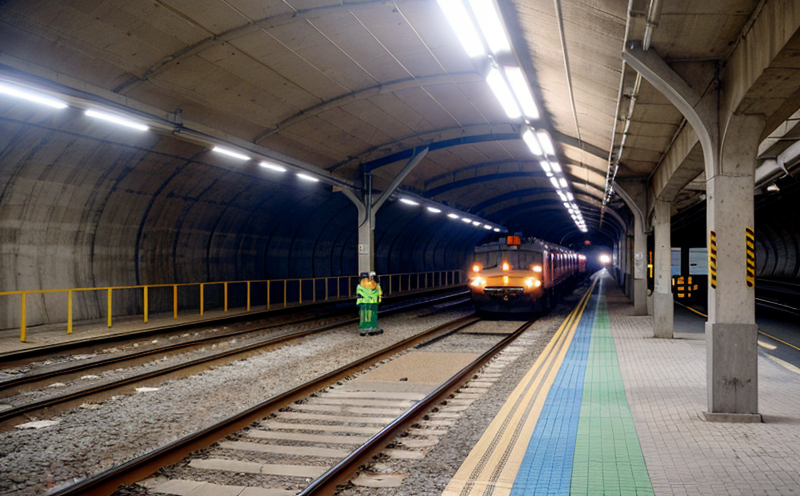EN 13230 Fatigue Testing of Bridge Sleepers
The European standard EN 13230 specifies the methodology for fatigue testing of bridge sleepers, ensuring their structural integrity and durability under cyclic loading conditions. This service is particularly critical in railway and transportation infrastructure where sleepers are subjected to repeated stress cycles due to constant traffic loadings.
Understanding the performance of a sleeper under fatigue loading helps engineers predict its lifespan accurately. Fatigue testing involves subjecting specimens to alternating loads that mimic real-world operating conditions, providing insights into material behavior and potential failure mechanisms. This process is crucial for ensuring compliance with safety regulations and optimizing maintenance schedules.
The standard EN 13230 requires the use of specific test equipment designed to apply precise cyclic loading to bridge sleepers. The testing setup typically includes a fatigue tester capable of applying controlled stress cycles, a computerized control system, and sensors for monitoring load and displacement. Specimens are carefully selected based on their intended service conditions, ensuring accurate representation of field performance.
Preparation of the test specimens is critical to ensure reliable results. This involves cleaning the sleepers thoroughly, marking them accurately, and positioning them in the fatigue testing machine according to specified procedures. The test setup must replicate as closely as possible the real-world conditions experienced by the sleepers during service.
During the test, load and displacement measurements are continuously monitored using high-precision instruments. These data provide critical information on how the sleeper deforms under stress and when it might start to fail. Post-test analysis of these data helps in identifying any weak points or potential areas of failure, which can be addressed through design improvements.
The results from EN 13230 fatigue testing are used by quality managers, compliance officers, R&D engineers, and procurement specialists to make informed decisions about the suitability of bridge sleepers for specific projects. Compliance with this standard is essential for ensuring that products meet safety and performance requirements set forth by regulatory bodies.
Engineers rely on these tests to optimize designs and materials used in railway infrastructure. By understanding how different sleeper types perform under cyclic loading, they can enhance the overall reliability of the system. This knowledge is particularly valuable when selecting new materials or modifying existing structures to better withstand environmental stresses and traffic loads.
The application of EN 13230 fatigue testing extends beyond just compliance; it also supports innovation in railway engineering by providing empirical data that can guide the development of more robust sleepers. The insights gained from these tests contribute significantly to advancing the field, ensuring safer and more efficient transportation systems.
In summary, EN 13230 fatigue testing plays a vital role in safeguarding infrastructure integrity while fostering continuous improvement through rigorous evaluation practices. It is an indispensable tool for those involved in designing, manufacturing, and maintaining railway sleepers.
Applied Standards
The European standard EN 13230 provides detailed guidelines on conducting fatigue tests for bridge sleepers. This standard ensures that the testing process adheres to internationally recognized best practices, ensuring consistency and reliability across different laboratories.
The application of this standard involves several key aspects:
- Specimen Preparation: Specimens must be prepared according to strict protocols outlined in EN 13230. This includes cleaning the sleepers, marking them for accurate tracking during testing, and positioning them correctly in the fatigue tester.
- Test Setup: The test setup must replicate real-world conditions as closely as possible. This includes using appropriate loading devices to apply cyclic loads that simulate the stress experienced by bridge sleepers during service.
- Data Collection: Continuous monitoring of load and displacement is essential for accurate data collection. Sensors placed on the specimens provide real-time feedback, which is crucial for interpreting test results correctly.
The standard also specifies acceptance criteria that determine when a sleeper has failed due to fatigue loading. These criteria are based on predefined levels of strain or stress before failure occurs, ensuring that only sleepers meeting these standards pass the test.
Benefits
Compliance with EN 13230 brings numerous benefits to various stakeholders involved in railway and transportation infrastructure:
- Enhanced Safety: By ensuring that bridge sleepers can withstand cyclic loading without failure, this standard significantly enhances the safety of railway systems. Increased Durability: Sleepers that pass fatigue testing according to EN 13230 are more likely to have longer service lives, reducing maintenance costs and downtime.
- Regulatory Compliance: Adhering to this standard ensures compliance with international regulations, thereby minimizing legal risks for manufacturers and operators.
- Improved Reputation: Successfully passing fatigue tests according to EN 13230 can enhance the reputation of a company among clients and industry peers.
The data generated from these tests also supports continuous improvement in product design, enabling manufacturers to introduce more robust and reliable sleepers into the market. This, in turn, contributes positively to the overall performance and safety of railway infrastructure.
Competitive Advantage and Market Impact
Engaging with our EN 13230 fatigue testing service offers several competitive advantages:
- Pioneering Technology: Our state-of-the-art equipment allows us to perform accurate and reliable tests that meet the highest international standards.
- Expertise: Leveraging our experienced technical team ensures that every aspect of the testing process is conducted with precision and adherence to best practices.
- Comprehensive Reporting: Our detailed reports provide clients with comprehensive insights into the performance of their sleepers, aiding in informed decision-making.
In a competitive market, demonstrating compliance with EN 13230 can set your products apart from others. It signals to potential buyers that you prioritize quality and safety, which are increasingly important factors for modern transportation infrastructure.
This service not only supports individual companies but also contributes positively to the broader industry by promoting higher standards of product reliability. As a leader in this field, we help drive innovation and continuous improvement within railway engineering.





